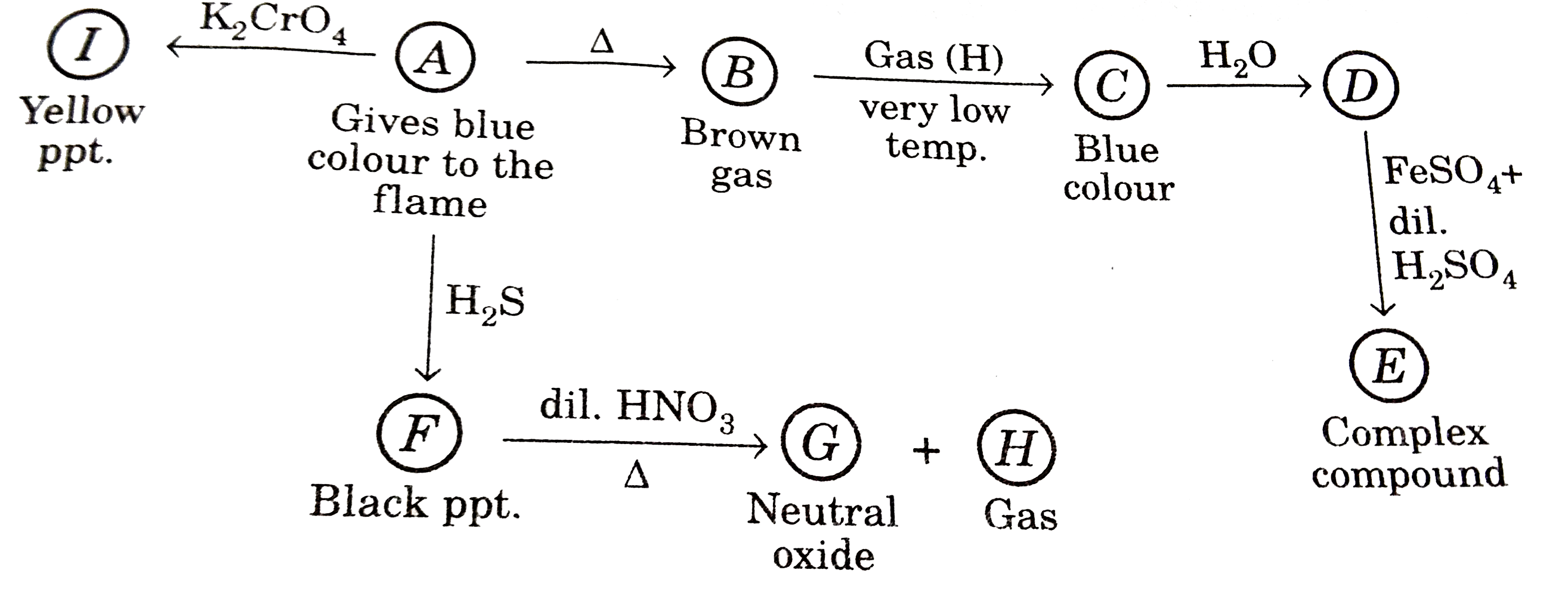When KI (excess) is added to a.CuSO4 b.HgCl2 c.Pb(NO3)2 1)a white ppt. of Cul in I, an orange ppt. H g I 2 , in II and a yellow ppt. P b I 2 , in III 2)a white ppt. of CuI in I, an orange ppt. dissoloving to H g I 2 − 4 in II, and an yellow ppt. of P b I 2 in III 3)a white ppt. of C u I , H g I 2 and P b I 2 in each case 4)none of the above is correctSolution in Malayalam
a white ppt. of Cul in l, an orange ppt. Hgl2 in II and a yellow ppt. Pbl2 in III
a white ppt. of Cul in I, an orange ppt. dissolving to Hgl2−4 in II, and an yellow ppt. of Pbl2 in II
a white ppt. of Cul, Hgl2 and Pbl2 in each case
none of the above is correct
The correct Answer is:B
Topper's Solved these Questions
- BOOK - BRILLIANT PUBLICATIONCHAPTER - THE D-AND F-BLOCK ELEMENTSEXERCISE - QUESTIONS (LEVEL-II)50videos
THE D-AND F-BLOCK ELEMENTS
- BOOK - BRILLIANT PUBLICATIONCHAPTER - THE D-AND F-BLOCK ELEMENTSEXERCISE - QUESTIONS (LEVEL-III)50videos
THE D-AND F-BLOCK ELEMENTS
- BOOK - BRILLIANT PUBLICATIONCHAPTER - THE D- AND F-BLOCK ELEMENTEXERCISE - LEVEL-II (ASSERTION-REASON TYPE)40videos
THE D- AND F-BLOCK ELEMENT
- BOOK - BRILLIANT PUBLICATIONCHAPTER - THE P-BLOCK ELEMENTS (XII) EXERCISE - LEVEL- II (GROUP 18 NOBLE GASES) (ASSERTION - REASON)5videos
THE P-BLOCK ELEMENTS (XII)
Similar Questions
Potassium permanganate acts as an oxidant in neutral, alkaline as well as acidic medium. The final products obtained from it in the three conditions are, respectively
View SolutionA metal M which is not affected by strong acids like conc. HNO3 conc. H2SO4 and concentrated solutions of alkalies like KOH and NaOH but dissolves in aqua-regia and forms MCI3 which is used for toning in photography. The metal M is:
01:35View SolutionAssertion : Zn, Cd and Hg are not considered as transition metals.
Reason :d-orbitals in Zn, Cd and Hg are completely filled, both in ground state and in their available oxidation states.View SolutionAssertion: N2 is less reactive than P
Reason: Nitrogen gas more negative electron gain enthalpy than phosphorousView Solution(A) (colourless solution ) gives white ppt (B) with NaOH solution but ppt dissolves in excess of NaOH forming (C ) (C ) does not give ppt with H_(2)S but on boiling with NH_(4)CI while ppt (B) appears (A) also gives yellow ppt with AgNO_(3) identify (A),(B) and (C )
View Solution(White ppt)DNa2CO3←−−−−−−−dil.H2SO4A↓C(White ppt)K2CrO4−−−−−−−−−→(in acetic acid)B(Yellow ppt)
If A is the metallic salt, then the white ppt. of D must be ofView SolutionA metal chloride (X) shows the following reactions : (i) When H_(2)S is passed in acidified aqueous solution of (X) a black ppt. is obtained. (ii) The ppt. obtained in step (i) is not soluble in yellow ammonium sulphide. (iii) When a solution of stannous chloride is added to an aqueous solution of X, a white ppt. is obtained which turns grey on addition of more stannous chloride. (iv) When an aqueous solution of KI is added to an aqueous solution of (X) a red ppt. is obtained which dissolved on addition of excess of KI. Identify X and write down equation for the reactions at step (i), (ii), (iii) & (iv).
View Solution
Yellow ppt. of compound (I) is insoluble in:03:18View Solution{:(FeCI_(3)"solution" +(NH_(4))_(2)S overset("Neutral medium")rarr,"Black ppt".(A)),(," "darrdil.H_(2)SO_(4)),(,"White ppt". (B) +Gas (C)):} while AICI_(3) solution +(NH_(4))_(2)S rarr White ppt.(D) What is the formula of black ppt.(A)?
04:21View SolutionFeCI3solution+(NH4)2SNeutral medium−−−−−−−−−→Black ppt.(A) ↓dil.H2SO4White ppt.(B)+Gas(C) while AICI3 solution +(NH4)2S→ White ppt.(D)
White ppt.(D) is :05:30View Solution{:(FeCI_(3)"solution" +(NH_(4))_(2)S overset("Neutral medium")rarr,"Black ppt".(A)),(," "darrdil.H_(2)SO_(4)),(,"White ppt". (B) +Gas (C)):} while AICI_(3) solution +(NH_(4))_(2)S rarr White ppt.(D) White ppt. (B) and gas (C) are:
View SolutionPbCl2+Kl→[A]Yellow ppt+KCl
[A]Yellow ppt+Klexcess→[B]Soluble
Compound [A] and [B] areView SolutionWater soluble mixture (i). BaCl2−−−−−−−−→(ii). dil .HClWhite ppt.
Filtrate+(Hot and conc.)HNO3+BaCl2→White ppt.
The mixture contains:View SolutionTo a solution containing Ca2+, Ag+, Cu+ and K+ 2 M HCl is added when a white ppt. (A) is obtained. After filtration H2S is passed through the filtrate, a black ppt. (B) is formed. On removing (B) by filtration it gave white ppt. (C) with conc. Na2CO3 solution. Identify (A),(B) and (C).
View SolutionIdentify A and B? Br_(2)+OHto A+B A+B+H^(+)toBr_(2) A gives yellow ppt, with AgNO_(3)
View SolutionLight green (compound 'A') overset(Delta)(to)"white Residue(B)"overset("high")underset("Temp.")C+D+E (i)'D' and 'E' are two acidic gas. (ii) 'D' is passed through HgCl_(2) solution to give yellow ppt. (iii) 'E' is passed through water first and then H_(2)S is passed, white turbidity is obtained. (iv) A is water soluble and addition of HgCl_(2) in it, yellow ppt. is obtained but white ppt does not turn into grey on addition of excess solution of 'A' Q. 'C' is soluble in :
03:31View Solution


